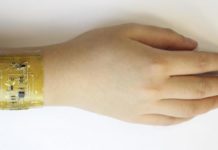
ITHACA, N.Y., March 4 (UPI) — New robotic “skin” developed by researchers at Cornell University can stretch up to six times its original size while still emitting light.
The electroluminescent material is inspired by the dynamic, light-producing skin of the octopus. The skin can stretch up to twice as much as the next-best stretchable display, and could be employed in the fields of health care, transportation and electronic communications.
“This material can stretch with the body of a soft robot, and that’s what our group does,” Rob Shepherd, assistant professor of mechanical and aerospace engineering, said in a press release. “It allows robots to change their color, and it also allows displays to change their shape.”
The skin’s hyper-elastic light-emitting capacitor, or HLEC, is made up of thin rubber pixels. The pixels are composed of sandwich-like layers, with transparent hydrogel electrodes surrounded by silicone. In addition to stretching and producing light, the skin can be electronically manipulated and respond to touch.
Researchers are working on incorporating their technology into both hard- and soft-bodied robotic systems. Their initial prototype — designed and built by Shepherd and a team of grad students — is a soft-bodied inchworm-like robot that scoots along the ground as it lights up.
As robots become more sociable and engaging the ability to change colors will be important — more than just a cool visual effect.
“When robots become more and more a part of our lives, the ability for them to have emotional connection with us will be important,” said Shepherd. “So to be able to change their color in response to mood or the tone of the room we believe is going to be important for human-robot interactions.”
Shepherd and his research partners described their new technology in a paper published Friday in the journal Science.





